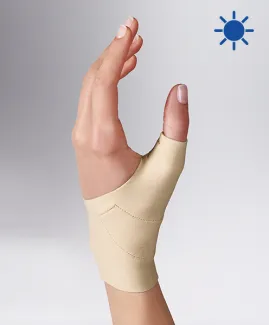
Thumb arthritis is most common in women. Indeed, 90% of arthritic thumb cases are post-menopausal women over 50 years of age. Consequently, we can wonder about what causes thumb arthritis. Does this mechanical dysfunction result from hormonal causes only? Finding the exact causes of thumb arthritis and preventing them is not as simple as we might think.
What are the causes of thumb arthritis?
Causes of thumb arthritis are still poorly known and difficult to identify. Many factors can help the development of thumb basal joint arthritis:
- age, which causes cartilage wear and weakness;
- inflammatory lesions that damage the cartilage (rheumatoid arthritis(1), chondrocalcinosis(2));
- traumatic lesions such as fractures, sprains or repeated luxations that deteriorate the solidity of the joint and sometimes its functions;
- intensive use of the joint is an important cause of thumb arthritis;
- ligament degeneration causes joint hyperlaxity(3).
What are the risk factors for thumb arthritis?
Some factors increase the risk of developing this condition. Among them, let’s name:
- occupational activities or hobbies that involve repeated movements(4). They are directly related to joint overuse: one of the major cause of thumb arthritis;
- constitutional laxity (unusual laxity of the thumb) can be caused by certain diseases (Marfan syndrome(5) or Ehler-Danlos syndrome(6));
- distinctive anatomical characteristics of the trapezium(7).
- thumb arthritis is also frequently associated with other conditions like trigger fingers, De Quervain tenosynovitis, flexor carpi radialis tendinitis(8). Arthritic thumb would be identified in 50% of patients with carpal tunnel syndrome(9). In this case, the symptoms of both conditions are combined;
- being exposed to recurrent vibrations at work for example is another cause of thumb arthritis.
Are thumb braces satisfying solutions to thumb arthritis?
One of the main causes of thumb arthritis are the risky movements of daily living. To face them, specific thumb braces and splints have been designed to limit those movements.
Many studies(10) were conducted to assess the effectiveness of braces, regardless of the brands and models. Braces are used as a first-line treatment to relieve the joint at the base of your thumb caused by thumb arthritis. They can also be worn as a complement to analgesics.
Systematically suggested to be worn at night, rigid braces can also be associated with daytime wearing of flexible braces. Flexible braces offer a perfect freedom of motion of the joint. They aim to preserve the hand's function during daily activities once the thumb pain has reduced.
2 complementary thumb support braces by EPITACT®
EPITACT® has created two braces intended to ease the pain caused by thumb arthritis.
The rigid brace for arthritic thumb* is to wear at night to immobilise the joint and place it in a resting position. It can also be used during the day if pain is too intense, on your doctor's recommendations.
The flexible brace for day* reduces traumatic micromovements without impeding mobility during daily activities (manual work, hobbies...).
What causes thumb arthritis remains unclear. It can be the result of several anatomical, traumatic or mechanical factors. However, things can be done to slow down the progression of the most common symptoms of thumb arthritis (pain, loss of strength in the hand, etc.) and fight against its risk factors. Discover the other treatment options that soothe the tenderness at the base of the thumb caused by thumb arthritis.
*These solutions are class I medical devices that bear the CE marking under this regulation. Carefully read the instructions before use. Manufacturer: Millet Innovation. 09/2021
For more details about this general and simplified approach, here are further sources:
(1)Vaghela KR, Patel NK, Sarraf KM, Owers K. Severe destructive arthritis of the carpometacarpal joint : a diagnosis of exclusion case report. Ortop Traumatol Rehabil 2013;15:653-7
(2)McCarthy GM, Carrera GF, Ryan LM. Acute calcific periarthritis of the finger joints : a syndrome of women. J Rheumatol 1993;20:1077-80
(3)Manson TT, Pfaeffle HJ, Herdon JH, Tomaino MM, Fischer KJ. Forearm rotation alters interosseous ligament strain distribution. J Hand Surg Am 2000;25:1058-63
(4)Carlson MG, Warner KK, Meyers KN, Hearns KA, Kok PL. Anatomy of the thumb metacarpophalangeal ulnar and radial collateral ligaments. J Hand Surg Am 2012;37:2021-6
(5)Szabo RM, Peterson B. Scaphotrapezial arthritis after a carpometa-carpal fusion in a patient with Marfan’s Syndrome : case report. J Hand Surg Eur Vol 2008;33:806-9
(6)Uzak AS, Fryns JP, Dundar M. Syndromes presenting adducted thumb with/without clubfoot and Dundar syndrome. Genet Couns 2014;25:159-69
(7)Saffar P, Goffin D, Galbiatti A. Dynamics of the thumb in arthritis. Ann Chir Main Memb Super 1990;9:21 2-8.
(8)Delcambre B, Bera-Louville A, Guyot-Drouot MH. Osteoarthritis of the fingers and trapeziometacarpal joints. Joint Bone Spine2001;68:339-47.
(9)Pellegrini VD Jr. Osteoarthritis at the base of the thumb. Orthop Clin North Am 1992;23:83-102
(10)Becker SJ, Bot AG, Curley SE, Jupiter JB, Ring.F D. JB. A prospective randomized comparison of neoprene vs thermoplast hand-based thumb spica splinting for trapeziometacarpal arthrosis. Osteoarthritis Cartilage 2013;21:668-75.
 Pharmacie
Pharmacie

